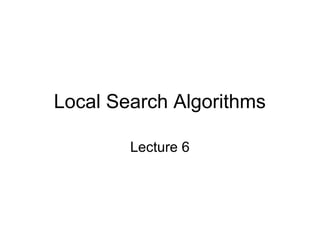Local search algorithms6
•Télécharger en tant que PPT, PDF•
0 j'aime•262 vues
Signaler
Partager
Signaler
Partager

Recommandé
Recommandé
Contenu connexe
Similaire à Local search algorithms6
Similaire à Local search algorithms6 (20)
Genetic-Algorithms for machine learning and ai.ppt

Genetic-Algorithms for machine learning and ai.ppt
Plus de yosser atassi
Plus de yosser atassi (11)
Local search algorithms6
- 11. Genetic Algorithm (GA) • Start with a large “population” of randomly generated “attempted solutions” to a problem • Repeatedly do the following: – Evaluate each of the attempted solutions – Keep a subset of these solutions (the “best” ones) – Use these solutions to generate a new population • Quit when you have a satisfactory solution (or you run out of time)
- 12. • Main idea: better individuals get higher chance – Chances proportional to fitness – Implementation: roulette wheel technique » Assign to each individual a part of the roulette wheel » Spin the wheel n times to select n individuals SGA operators: Selection fitness(A) = 3 fitness(B) = 1 fitness(C) = 2 A C 1/6 = 17% 3/6 = 50% B 2/6 = 33%
- 13. crossover • Choose a random point on the two parents • Split parents at this crossover point • Create children by exchanging tails • Pc typically in range (0.6, 0.9)
- 14. mutation • Alter each gene independently with a probability pm • pm is called the mutation rate – Typically between 1/pop_size and 1/ chromosome_length
- 15. Simple problem: max x2 over {0,1,…,31} GA approach: Representation: binary code, e.g. 01101 ↔ 13 Population size: 4 1-point xover, bitwise mutation Roulette wheel selection Random initialisation We show one generational cycle done by hand An example